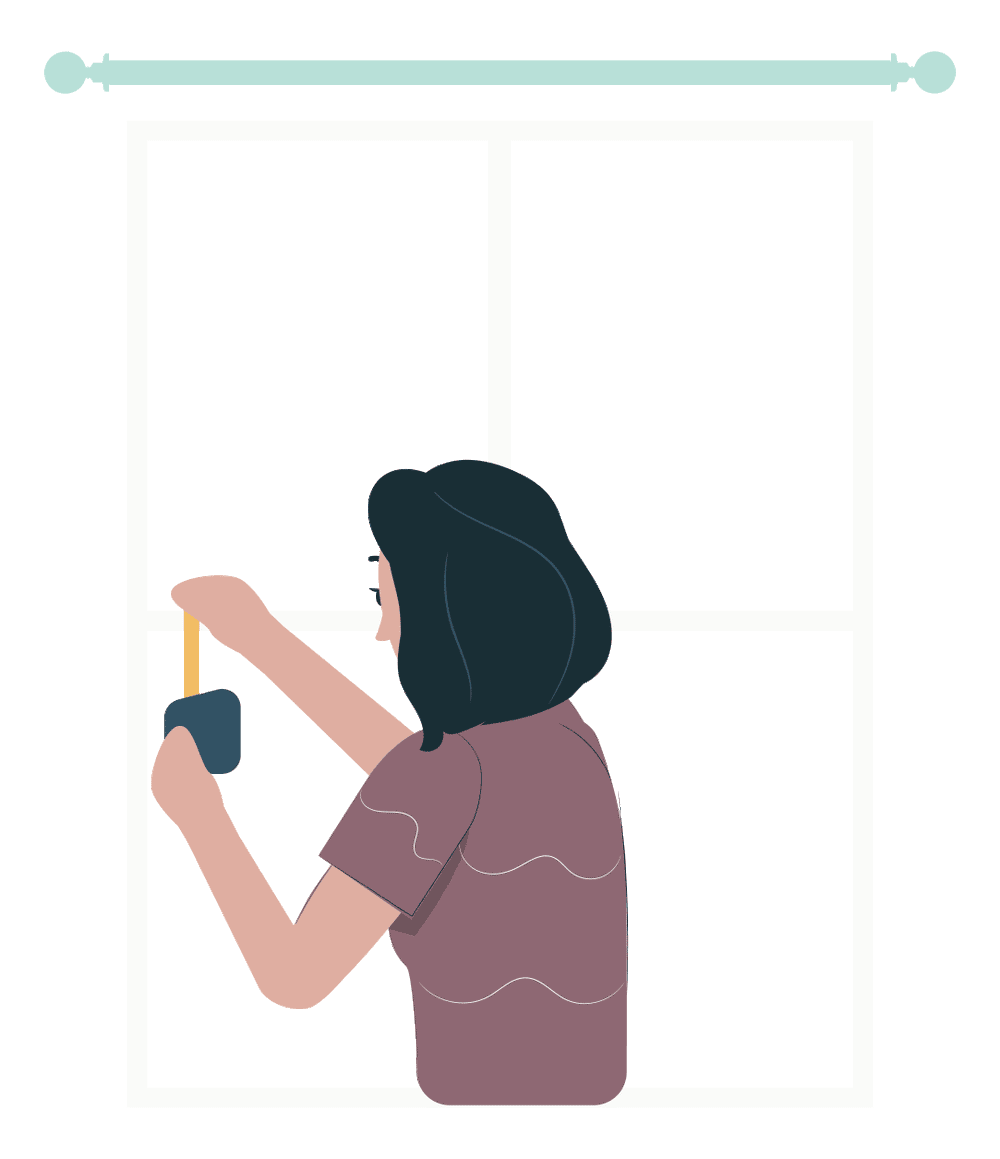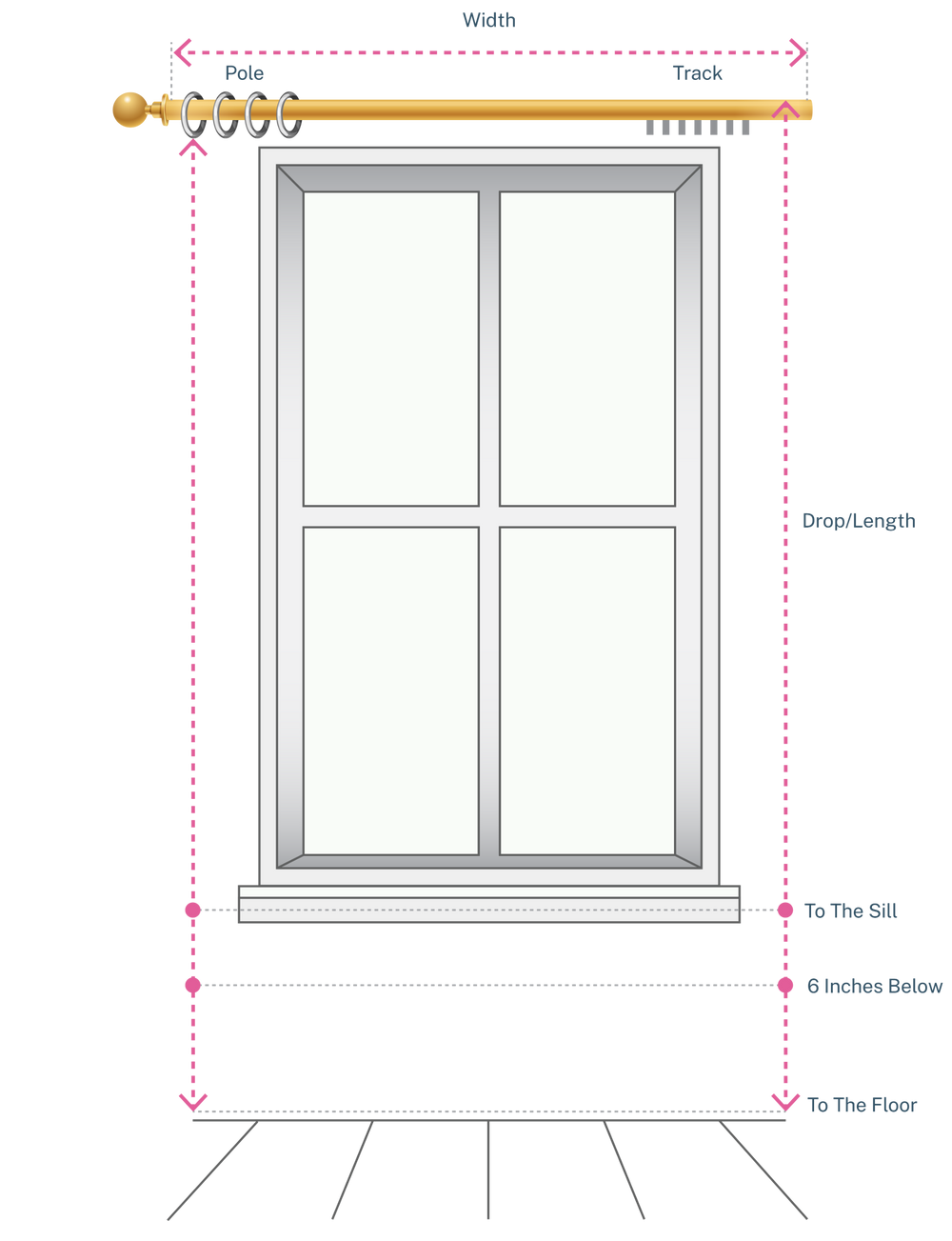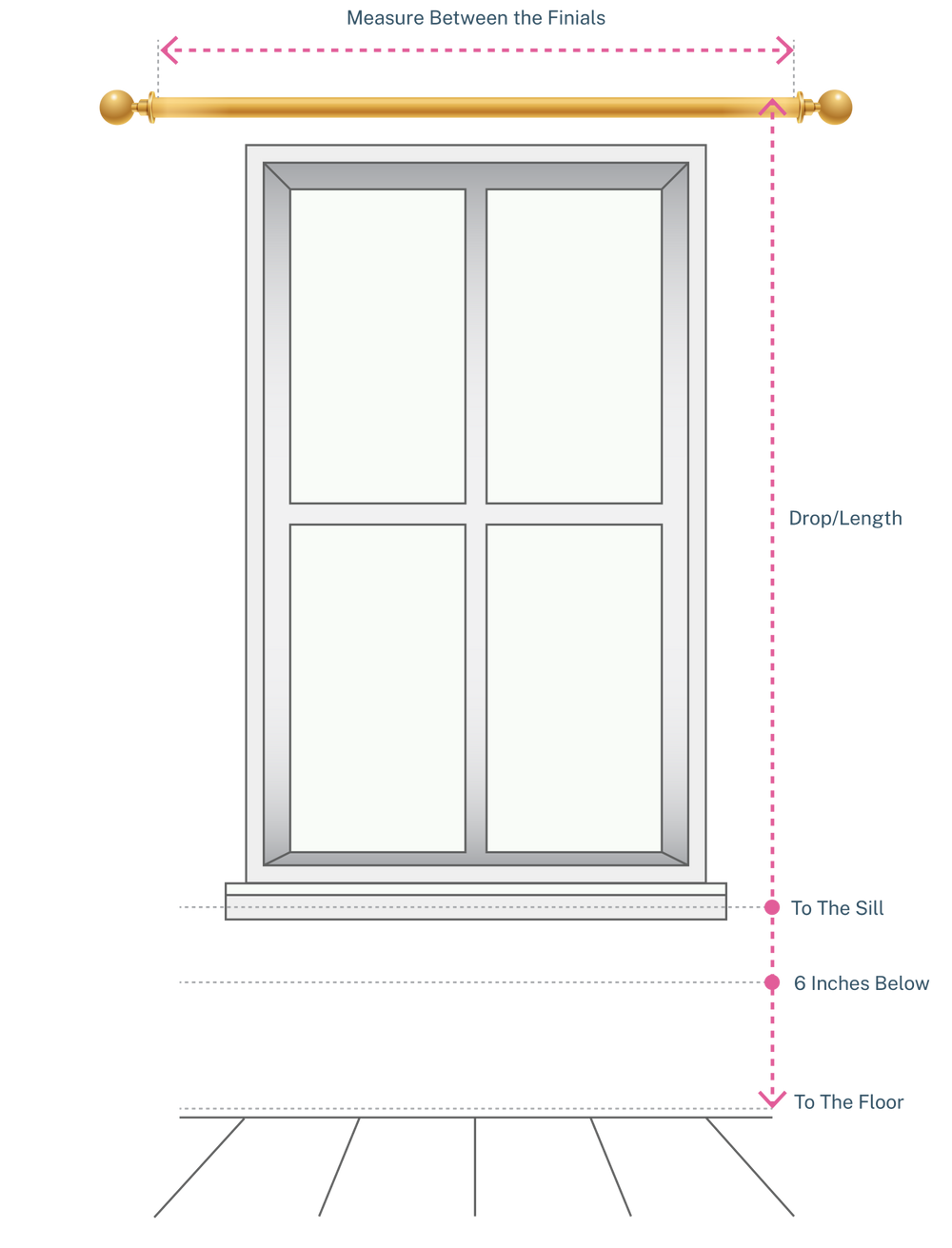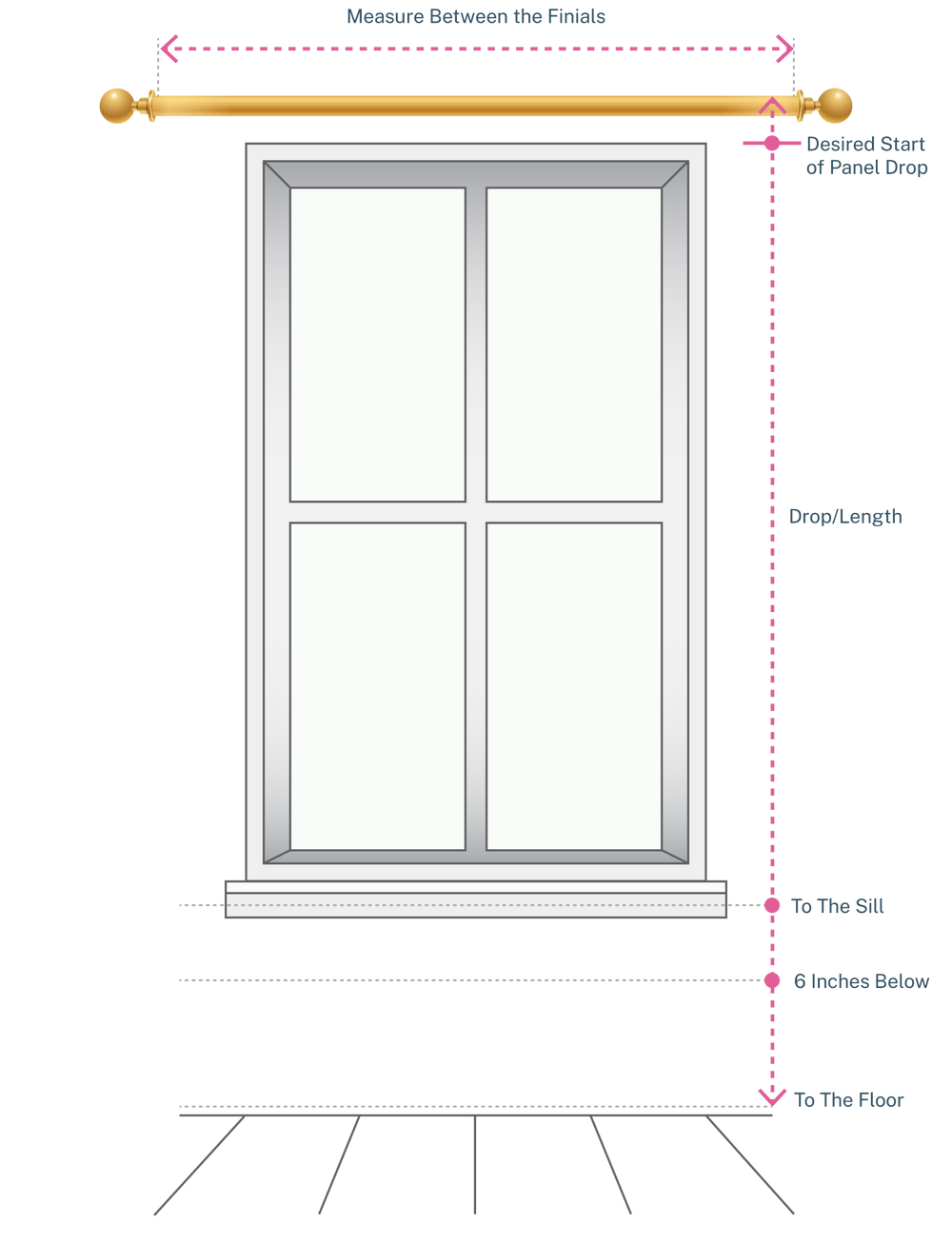HOW TO MEASURE CURTAIN LENGTH & WIDTH
Whether you’re eyeing the oozing drama of long puddled drapes or the cozy chic of short cafe curtains, precise inches are the ink to your perfect drape-story. But let's be honest, measuring for window treatments can feel like wrestling with a mischievous measuring tape.
Fear not though; with a little care and attention — and the support of this guide — you’ll have those measurements dialed in, in no time. So, once you’ve decided on your curtains’ heading style, go ahead — measure with confidence — and let your windows make a statement that’s both precise and personal!


HOMESEWN WISDOM TO GET YOU STARTED
- USE STEEL TAPE: When you want your measurements to be spot-on, reach for a steel tape measure. Fabric and plastic ones tend to stretch over time, and we all know that’s a recipe for wonky specs.
- DO NOT PROVIDE POLES/ TRACKS/ WINDOW SIZES: When ordering drapes from Sewn, do not enter sizes of your windows, poles or tracks. We require the final sizes of the ready curtain panels you’d like us to stitch. For instance, if your window width is 50 inches, and you’d like us to sew a 100 inch wide panel for lush pleats, please specify 100 inch panel width in your order, not the 50 inch window width.
- MEASURE MULTIPLE WINDOWS INDIVIDUALLY: Many windows - even when they ‘seem’ identical - can vary just enough in sizes to make a difference. So, look past these tricksters with their sizing quirks - and measure each window individually when placing your order for multiple windows.
- BUY PER PANEL, NOT PER PAIR: All prices listed on our site are per panel, not per pair. If you’d like to purchase a pair of curtains, please ensure you choose and pay for two panels while placing your order.
- EXPECT SEAMS: Fabric bolts typically measure 54 inches wide, so for most curtains exceeding 48 inches in width, vertical seams might come into play. But don’t worry — these hems are adeptly handled by our tailors to be as discreet as possible. For more details on joins and hems for pattern matching in extra-wide curtains, please refer to our blog on ‘Joins & Seams in Custom Window Treatments’.
Heading style

-
How To Measure Length
If you’re hanging your pinch pleat drapes from a decorative pole with rings, and you want the hardware to be visibly part of the show, start measuring just below the curtain rings down to your desired endpoint. This will allow the rings and pole to shine as a design feature along with the curtains.
On the other hand, if you’re using a track and would prefer to hide the hardware, measure from the top of the track to your chosen endpoint.
The endpoint of your curtain is solely at your discretion based on your setting and personal style preferences. You may want your kitchen cafe curtains to stop at the window sill, but your formal living room curtains to puddle luxuriously on the floor.
If you’re unsure about drapery lengths and looking for help to decide your new curtains’ endpoint, please refer to our blog post on ‘How Long Should My Curtains Be?’
-
How To Measure Width
Pinch pleat curtains are constructed with pre-sewn pleats. The pleats are ‘fixed’ and not adjustable, as is the case with ‘hand-gathered’ styles like grommet tops or rod pocket tops. For this reason, it's important to be precise when specifying panel widths for pinch pleat styles.
The type of hardware you use will also influence the width of your pinch pleat curtains, so please do factor in whether you’re using curtain tracks, standard drapery poles, or French return drapery poles. Then, depending on the hardware you have or plan to purchase, here’s how to measure for panel width:
Drapery Poles:
- Measure the length of your drapery pole (finial to finial).
- If ordering a single panel, add 6-8 inches to this measure and specify that figure as your finished panel width. These extra inches account for the ‘return’ of your drapes, ensuring minimal light leaks from the edges.
- For a pair of curtains, we advise adding 12 inches to the length of the pole and dividing by two to arrive at the width of each panel. In case of a pair, these extra inches account for the ‘return’ as well as overlap in the middle, ensuring no light leaks from the edges or the middle.
- As an example, if your pole length is 60 inches, we recommend ordering two drapery panels of (60 + 12) ÷ 2 = 36 inches, or a single panel of 66-68 inches.
French Return Drapery Pole:
- Measure the full length of the drapery pole, including the curving returns (typically 4 inches on each end).
- If ordering a single curtain panel, use the entire pole length as the panel's width.
- For a pair of curtains, add four inches to your measured pole length, then divide by two to determine the width of each panel. The extra four inches is to ensure a comfortable overlap between the two panels when drawn shut, thereby eliminating chances of any light leaks in the middle.
- As an example, if your pole length (including the returns) is 60 inches, we recommend ordering two drapery panels of (60 + 4) ÷ 2 = 32 inches, or a single panel of 60 inches.
Drapery Tracks:
- Measure the length of your track, end to end.
- If ordering a single curtain panel, use the entire track length as the panel’s width. For a pair of curtains, add four inches to your measured track length, then divide by two to determine the width of each panel. The extra four inches is to ensure a comfortable overlap between the two panels when drawn shut, thereby eliminating chances of any light leaks in the middle.
- As an example, if your track length is 60 inches, we recommend ordering two drapery panels of (60 + 4) ÷ 2 = 32 inches, or a single panel of 60 inches.
- If you have split curtain tracks with an overlap built in the middle, measure the width of each track individually end to end, and specify these individual numbers as widths for your two panels.
-
How To Hang
Hanging your pinch pleat curtains from Sewn is easy. Refer to our heading style guides for styling tips and instructions on how to hang your chosen style of pinch pleat curtains:

-
How To Measure Length
Measuring the length for rod pocket top, back tab top, or tab top curtains is quite simple. Start at the top of the drapery pole and measure straight down to your desired endpoint. Just remember to always measure from the top of the drapery pole, not the underside.
As to what the endpoint should be, it’s largely driven by your vision for the setting. You may choose your curtains to stop at the sill in a kitchen, or go grand with floor-length drapery for living rooms. If you’re unsure about drapery lengths and looking for help to decide your new curtains’ endpoint, please refer to our blog post on ‘How Long Should My Curtains Be?’
HOMESEWN WISDOM: Our rod pocket top curtains are sewn with 2.5 inch wide pockets. If you'd like a different size — larger or smaller — just drop us a line at hi@sewndrapesandshades.com before placing your order, and we'll happily tailor it to your specifications. Similarly, the tabs in top top & back tab top styles are sewn to be four inches long and two inches wide, but we’re happy to customize to your preference.
-
How To Measure Width
Unlike pinch pleated curtains that come with sewn-in fullness and fixed pleats, styles such as tab tops, back tab tops, and rod pocket tops are ‘hand-gathered’ on the pole to form pleats. Therefore, for these drapes to form dense pleats, ample panel width - calculated based on the desired ‘fullness factor’ - has to be ensured.
Drapery fullness refers to the amount of fabric required to create the desired volume of pleats or ‘gather’ in a curtain. It is expressed as a ratio, indicating how much fabric width is employed compared to the width of the window or curtain rod. The higher the fullness factor, the higher the curtain width, and therefore the more luxurious/ denser you can expect your drapery pleats to be.
For back tab and rod pocket top curtains, we generally recommend a fullness factor of 2x. For tab-top curtains, however, a fullness of 1.5x is advised. Why? This adjustment preserves the casual, relaxed charm of the style while preventing the tabs from overcrowding or bunching when the drapes are stacked to the sides. This means that for back tabs and rod pockets, the total curtain panel width should be double the drapery pole's width, while for tab tops, it’s best kept at 1.5 times the pole’s width. Let us explain with examples.
BACK TAB TOPS & ROD POCKET TOPS: Start by measuring your drapery pole (finial to finial). Then, double that figure for 2x fullness. This should be the final width of your curtain panel altogether. So, if your drapery pole measures 60 inches, we advise ordering a single drapery panel of 120 inches, or two panels of 60 inches each. If you happen to be on a budget or keen on a less ‘full’ look for your drapes, you can also consider reducing the fulling factor from 2x to 1.5x. Avoid dipping below 1.5x fullness though. Anything less risks a "flat sheet" look rather than those chic folds you're after.
TAB TOPS: Multiply the length of your drapery pole (measured finial to finial) by 1.5 for 1.5x fullness. So, if your pole is 60 inches long, you’d ideally need a total curtain width of 90 inches — as either a single panel measuring 90 inches or two panels of approximately 45 inches each. If your chosen fabric has low body volume - like a sheer or semi sheer - you can consider increasing the fullness factor up to 2x for a richer gather.
-
How to Hang
Hanging your curtains from Sewn is easy. Please refer to our heading style guides for styling tips and instructions on how to hang your chosen style of curtains:

-
How to Measure Length
To arrive at panel length for grommet top curtains or rod pocket top curtains with frill headers, start by measuring the length from the top of your drapery pole to the desired endpoint. Then, add 1.5 inches to this figure - and the resulting number should be specified as the final length of your panels on our site.
This 1.5 inch addition accounts for the ‘upstand’— the fabric portion of the panel that sits above the pole in grommet top curtains. Similarly, for rod pocket curtains with frill headers, the extra 1.5 inches ensures the decorative frill is included in the final length.
The endpoint of your curtain is solely at your discretion based on your setting and personal style preferences. You may want your kitchen cafe curtains to stop at the window sill, but your formal living room curtains to puddle luxuriously on the floor.
If you’re unsure about drapery lengths and looking for help to decide your new curtains’ endpoint, please refer to our blog post on ‘How Long Should My Curtains Be?’
HOMESEWN WISDOM: Our rod pocket top curtains are sewn with 2.5 inch wide pockets. If you'd like a different size — larger or smaller — just drop us a line at hi@sewndrapesandshades.com before placing your order, and we'll happily tailor it to your specifications.
-
How to Measure Width
Unlike pinch pleated curtains that come with sewn-in fullness and fixed pleats, styles such as grommet tops and rod pocket tops are ‘hand-gathered’ on the pole to form pleats. Therefore, for these drapes to form dense pleats, ample panel width - calculated based on the desired ‘fullness factor’ - has to be ensured.
Drapery fullness refers to the amount of fabric required to create the desired volume of pleats or ‘gather’ in a curtain. It is expressed as a ratio, indicating how much fabric width is employed compared to the width of the window or curtain rod. The higher the fullness factor, the higher the curtain width, and therefore the more luxurious/denser you can expect your drapery pleats to be.
For grommet top and rod pocket curtains with frills, we generally recommend a fullness factor of 2x. This means that the total curtain panel width should ideally be twice the width of the drapery pole.
To arrive at the final panel width for your order, measure the width of your pole (finial to finial). Double that number to get your total curtain width. For two panels, divide this total width by two, and the resulting number should be the per panel width entered at the time of ordering on our site.
For example, if your window is 100 inches wide, you’d ideally order either a single panel of width 200 inches, or two panels of 100 inches width each.
If you’d like a more minimal look with shallower pleats for your curtains - or are perhaps on a budget - you could opt to order curtains with a lower fullness factor - 1.5x for example. In this case, for the same 100 inch pole, a single panel at 75 inches, or a pair of panels for about 36 inches will offer the desired look.
Avoid dipping below 1.5x fullness though. Anything less risks a "flat sheet" look rather than those chic folds you're after.
-
How to Hang
Hanging your curtains from Sewn is easy. Refer to our heading style guides for styling tips and instructions on how to hang your chosen style of curtains:

-
How To Measure Length
Flat panel curtains can be hung from both curtain tracks and poles, and the length may slightly vary depending on the hardware you choose.
When hanging flat panel drapes from tracks, clients generally prefer to hide the track. Therefore, the measurement needs to be taken from the top of the tracks to the desired endpoint. Alternatively, if you’d like your tracks to show, start measuring from the underside of the track.
If you are planning to hang your flat panel top curtains from a pole, you may either use drapery rings and pins or curtain clips.
- If using rings and pins, take the measurement starting from the ‘underside’ of the rings to the desired endpoint.
- If using curtain clips, the drop length of the clips needs to be accounted for. In this case, start measuring the length from the underside of the ‘open’ clip to the desired endpoint.
The endpoint of your curtain is solely at your discretion based on your setting and personal style preferences. You may want your kitchen cafe curtains to stop at the window sill, but your formal living room curtains to puddle luxuriously on the floor.
If you’re unsure about drapery lengths and looking for help to decide your new curtains’ endpoint, please refer to our blog post on ‘How Long Should My Curtains Be?’
-
How To Measure Width
Unlike pinch pleated curtains that come with sewn-in fullness and fixed pleats, styles such as flat panel tops are ‘hand-gathered’ on the pole to form pleats. Therefore, for flat panel tops to form dense pleats, ample panel width - calculated based on the desired ‘fullness factor’ - has to be ensured.
Drapery fullness refers to the amount of fabric required to create the desired volume of pleats or ‘gather’ in a curtain. It is expressed as a ratio, indicating how much fabric width is employed compared to the width of the window or curtain rod. The higher the fullness factor, the higher the curtain width, and therefore the more luxurious/denser you can expect your drapery pleats to be.
For flat panel top curtains, we generally recommend a fullness factor of 2x. This means that the total curtain panel width should ideally be twice the width of the drapery pole/ track.
To arrive at the final panel width for your order, measure the width of your track or pole (finial to finial). Double that number to get your total curtain width. For two panels, divide this total width by two, and the resulting number should be the per panel width entered at the time of ordering on our site.
For example, if your window is 100 inches wide, you’d ideally order either a single flat panel top curtain of width 200 inches, or two panels of 100 inches width each.
If you’d like a more minimal look with shallower pleats for your curtains - or are perhaps on a budget - you could opt to order curtains with lower fullness factor - 1.5x for example. In this case, for the same 100 inch pole, a single panel at 75 inches, or a pair of panels for about 36 inches will offer the desired look.
Avoid dipping below 1.5x fullness though. Anything less risks a "flat sheet" look rather than those chic folds you're after.
-
How To Hang
Hanging your flat panel curtains from Sewn is a breeze. For styling tips and step-by-step instructions on mounting your drapes, please refer to our Style Guide for Flat Panel Drapes.

-
How to Measure Length
Pencil pleat curtains can be hung from both drapery poles and tracks, and how you measure for the length of your pencil pleat panels will vary depending on your choice of hardware. Here’s how:
CURTAIN TRACKS: When using curtain tracks, most clients prefer the track to be hidden. In this case, the drapery length should be measured from the top end of the track to the desired endpoint. On the other hand, if you’d like your curtain track to show, measure from the ‘underside’ of the curtain track.
DRAPERY POLES: If you are hanging your drapes from show-worthy drapery poles and rings, start measuring the length of your drapes from the underside of the curtain rings to the desired endpoint. Conversely, if you would like the pole to remain hidden, measure from the top end of the pole.
As to what the exact endpoint should be, pencil pleat curtains can don both floor-length elegance and short-length sleekness with equal splendor. The choice ultimately depends on your space, needs and aesthetic preferences. If you’re unsure about drapery lengths and looking for help to decide your new curtains’ endpoint, please refer to our blog post on ‘How Long Should My Curtains Be?’
-
How to Measure Width
Pencil pleat curtains should ideally be sewn/purchased with ‘2x fullness’, that is, in panel width that is double the width of the window.
Let us explain with an example:
If your drapery track/ pole measures 60 inches in length, your panels should ideally be 120 inches wide altogether. So, you may either order a single panel measuring 120 inches, or two panels measuring 60 inches each.
If you’ve chosen a sheer fabric and are keen on a dense pleat gathering, you may consider a higher fullness factor to make up for low body volume. Conversely, if you're working with a limited budget or prefer a less ‘full’ look, you can reduce the fullness to 1.5x. We do advise against going below this threshold of 1.5x, as curtains with lower width than this tend to hang like flat sheets, lacking the elegant pleats that define their appeal.
HOMESEWN WISDOM: Pencil pleat curtains come with a drawstring header tape at back. Drawstrings are pulled to gather the panel into pleats, and depending on how tightly one pulls the strings, the hanging width of the panels can be widened or contracted. So, for example, if a pencil pleat curtain panel is sewn to be 100 inches wide, it can cover windows with a width ranging from 40 inches to 60 inches. This incredible flexibility proves beneficial when changing homes as pencil pleat curtains can adapt width to the new settings easily.
-
How to Hang
For styling tips and step-by-step instructions on how to hang your pencil pleat drapes, please refer to our Style Guide for Pencil Pleat Curtains.

-
How to Measure Length
Tie tops are one of the few styles of curtains that offer a high level of flexibility with the final length of the curtain. This is because the exact length and end point of the drapery can be adjusted based on how loosely or closely to the pole one ties the signature knots of their tie top panels. So surgical precision is not essential for taking the measurements as in most other heading styles.
Our tie top curtains come with 10 inches long fabric strips running across the width of the panel. Please note that the length specified in your drapery order with us should not include the length of these strips.
To measure the length of a tie top curtain, simply measure from the point at which you’d ideally like the ‘panel portion’ of your curtains to start, to the desired drop point.
So, first, discern the starting point of the panel. It will depend on the look you want to go for - loosely tied strips with noticeable gap between the pole and the panel, or tightly tied knots - sitting close to the pole - with a very little gap. Define the look and you will have defined the starting point of the panel.
Second, discern the endpoint. The curtain can stop - at the sill, a few inches below the sill, at the floor or puddle on the floor. The choice ultimately depends on your space, needs and aesthetic preferences. If you’re unsure about drapery lengths and looking for help to decide your new curtains’ endpoint, please refer to our blog post on ‘How Long Should My Curtains Be?’
After you receive your curtains with the specified measurements, you still have plenty of room for experimentation and stylising. By changing the style of knotting and the length of the tied loop, you can make the curtains longer or shorter as you wish.
-
How to Measure Width
While a dense gather is often desirable for other header styles, tie top curtains look their best with a less full look. Therefore, we advise clients to order tie top curtains with 1.5x fullness, instead of 2x fullness that we recommend for many other styles.
What does that mean? Let us explain with an explain:
Measure your drapery pole - finial to finial - and multiply the figure by 1.5. So, if your pole measures 50 inches, the total width of your drapery should be (50x1.5 = 75) inches. For a pair of curtains, this would mean ordering each panel at a width of 37.5 inches approximately.
If you have chosen lightweight fabrics like sheers, you may opt for up to 2x fullness, in which case you would have to simply double the measurement of your drapery pole. Therefore, for a 50-inch long drapery pole, you’d ideally order a single panel of 100 inches or two panels of 50 inches each.
-
How to Hang
Hanging your tie top curtains from Sewn is a breeze. For styling tips and step-by-step instructions on how to hang your tie top drapes, please refer to our Style Guide for Tie Top Curtains.
